A Critical Evaluation of the Impacts of Fixed-Income Market Investment
VerifiedAdded on 2022/10/12
|15
|3916
|14
Report
AI Summary
This report provides a critical analysis of investment in fixed-income markets, examining their historical context, definition, and role within global financial markets. It delves into the features of bonds, including face value, interest rates, maturity, and yield to maturity, alongside a discussion of various perspectives such as political, interest rate, inflation, and business perspectives. The report evaluates the strategies and expectations of bond investors, exploring both the positive impacts, such as diversified portfolios and stable income, and the negative impacts of fixed-income investments. The report also covers the role of financial exchanges, and over-the-counter markets, offering a comprehensive overview of the fixed-income market and its implications for investors.
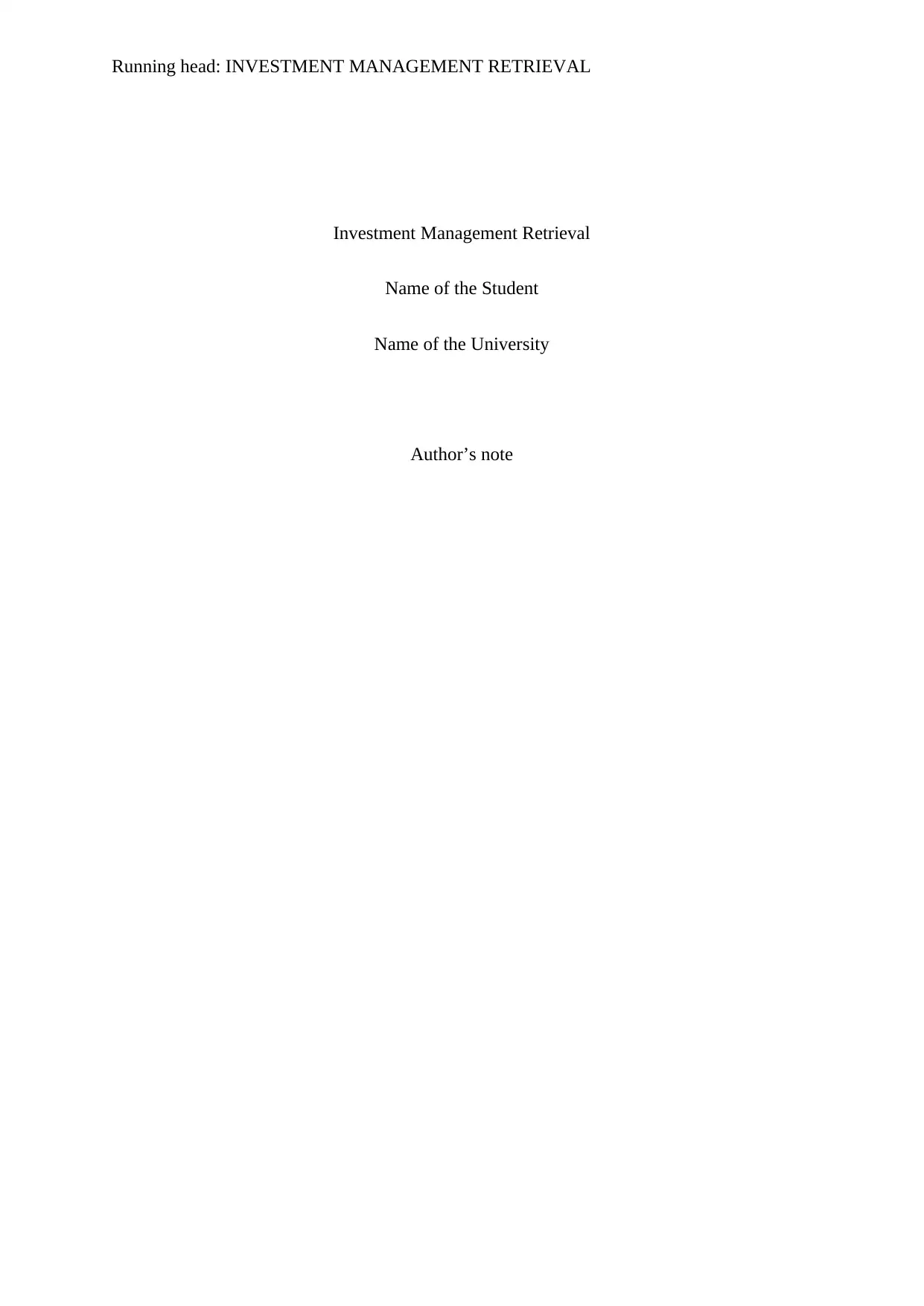
Running head: INVESTMENT MANAGEMENT RETRIEVAL
Investment Management Retrieval
Name of the Student
Name of the University
Author’s note
Investment Management Retrieval
Name of the Student
Name of the University
Author’s note
Paraphrase This Document
Need a fresh take? Get an instant paraphrase of this document with our AI Paraphraser
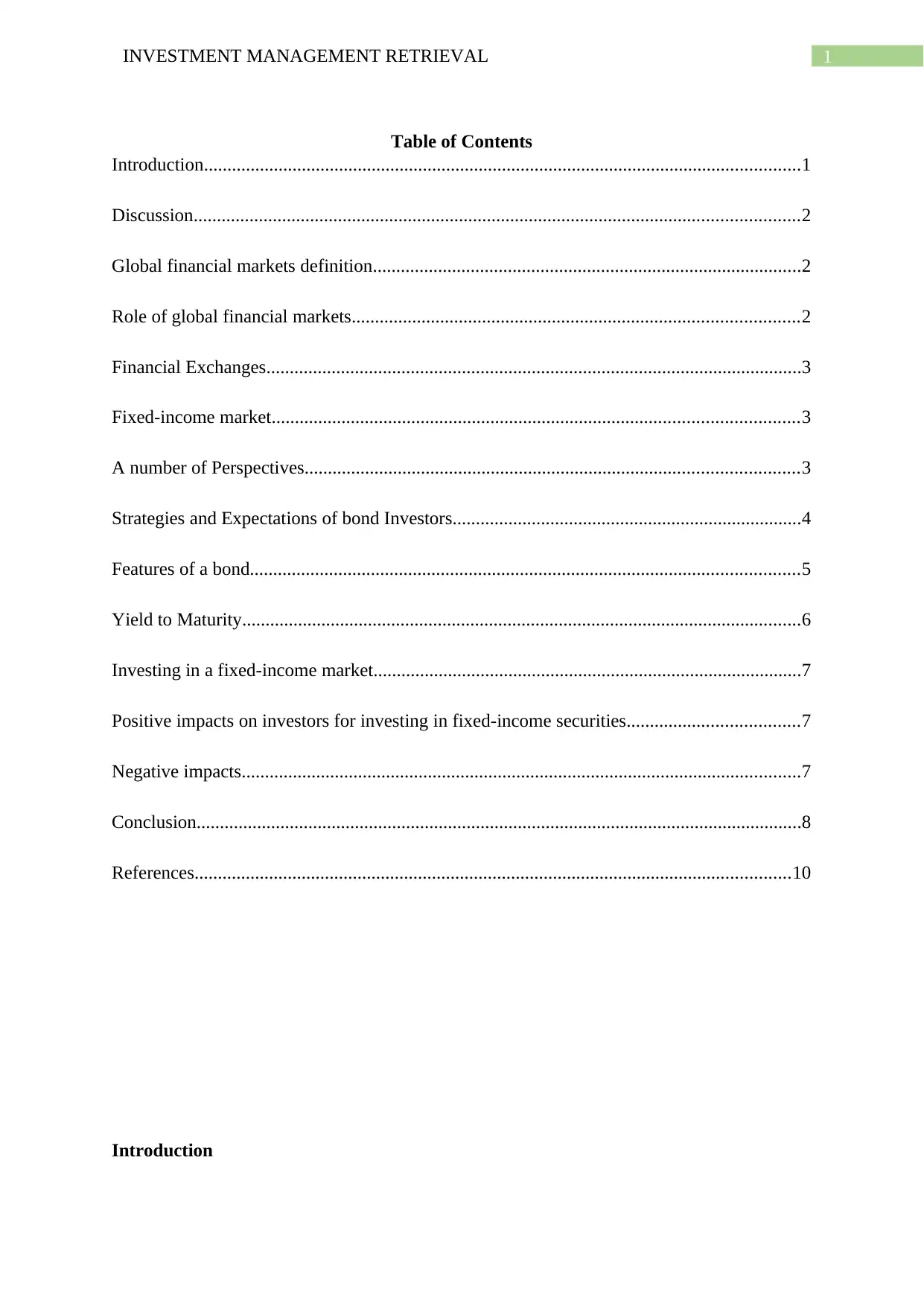
1INVESTMENT MANAGEMENT RETRIEVAL
Table of Contents
Introduction................................................................................................................................1
Discussion..................................................................................................................................2
Global financial markets definition............................................................................................2
Role of global financial markets................................................................................................2
Financial Exchanges...................................................................................................................3
Fixed-income market.................................................................................................................3
A number of Perspectives..........................................................................................................3
Strategies and Expectations of bond Investors...........................................................................4
Features of a bond......................................................................................................................5
Yield to Maturity........................................................................................................................6
Investing in a fixed-income market............................................................................................7
Positive impacts on investors for investing in fixed-income securities.....................................7
Negative impacts........................................................................................................................7
Conclusion..................................................................................................................................8
References................................................................................................................................10
Introduction
Table of Contents
Introduction................................................................................................................................1
Discussion..................................................................................................................................2
Global financial markets definition............................................................................................2
Role of global financial markets................................................................................................2
Financial Exchanges...................................................................................................................3
Fixed-income market.................................................................................................................3
A number of Perspectives..........................................................................................................3
Strategies and Expectations of bond Investors...........................................................................4
Features of a bond......................................................................................................................5
Yield to Maturity........................................................................................................................6
Investing in a fixed-income market............................................................................................7
Positive impacts on investors for investing in fixed-income securities.....................................7
Negative impacts........................................................................................................................7
Conclusion..................................................................................................................................8
References................................................................................................................................10
Introduction
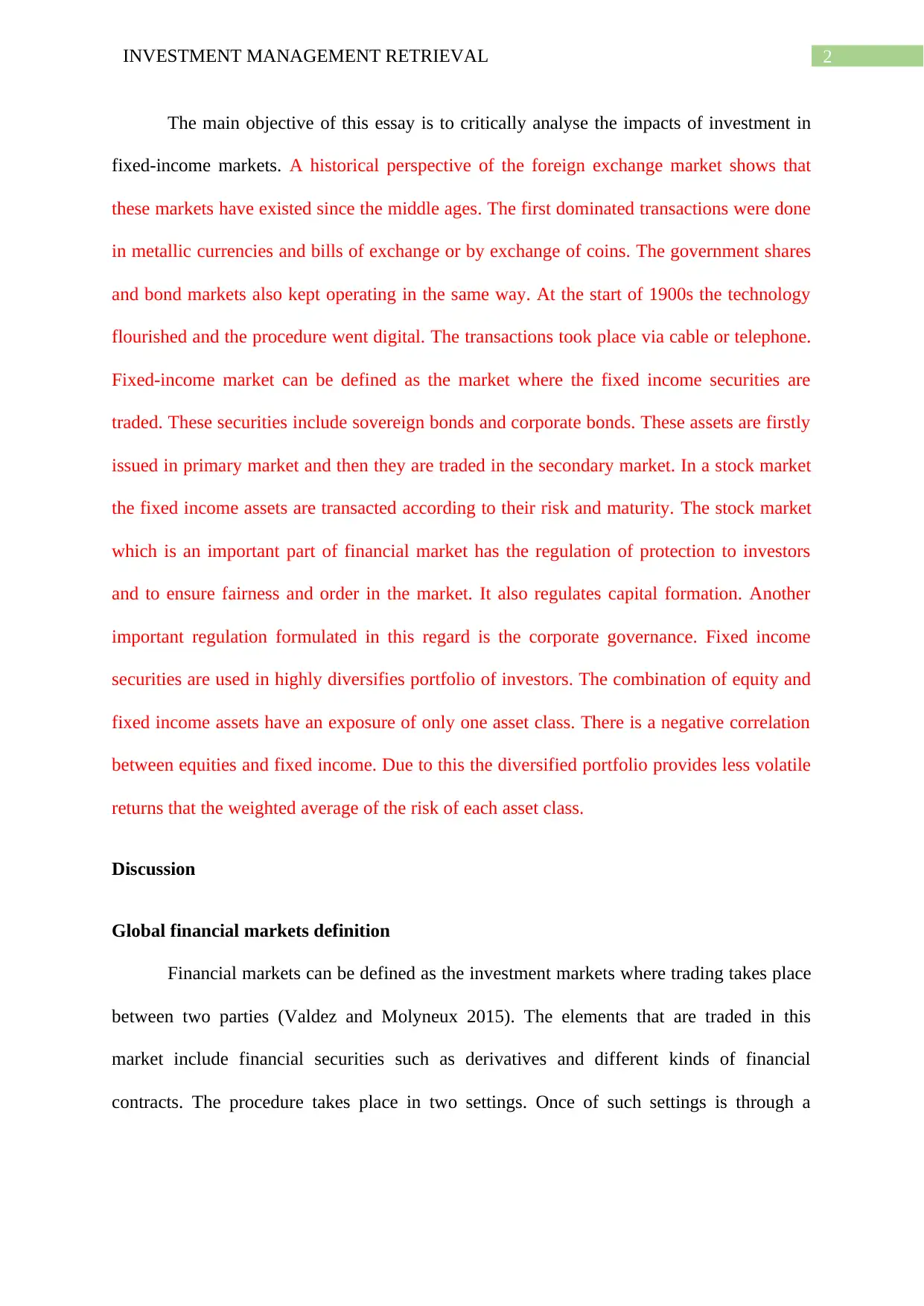
2INVESTMENT MANAGEMENT RETRIEVAL
The main objective of this essay is to critically analyse the impacts of investment in
fixed-income markets. A historical perspective of the foreign exchange market shows that
these markets have existed since the middle ages. The first dominated transactions were done
in metallic currencies and bills of exchange or by exchange of coins. The government shares
and bond markets also kept operating in the same way. At the start of 1900s the technology
flourished and the procedure went digital. The transactions took place via cable or telephone.
Fixed-income market can be defined as the market where the fixed income securities are
traded. These securities include sovereign bonds and corporate bonds. These assets are firstly
issued in primary market and then they are traded in the secondary market. In a stock market
the fixed income assets are transacted according to their risk and maturity. The stock market
which is an important part of financial market has the regulation of protection to investors
and to ensure fairness and order in the market. It also regulates capital formation. Another
important regulation formulated in this regard is the corporate governance. Fixed income
securities are used in highly diversifies portfolio of investors. The combination of equity and
fixed income assets have an exposure of only one asset class. There is a negative correlation
between equities and fixed income. Due to this the diversified portfolio provides less volatile
returns that the weighted average of the risk of each asset class.
Discussion
Global financial markets definition
Financial markets can be defined as the investment markets where trading takes place
between two parties (Valdez and Molyneux 2015). The elements that are traded in this
market include financial securities such as derivatives and different kinds of financial
contracts. The procedure takes place in two settings. Once of such settings is through a
The main objective of this essay is to critically analyse the impacts of investment in
fixed-income markets. A historical perspective of the foreign exchange market shows that
these markets have existed since the middle ages. The first dominated transactions were done
in metallic currencies and bills of exchange or by exchange of coins. The government shares
and bond markets also kept operating in the same way. At the start of 1900s the technology
flourished and the procedure went digital. The transactions took place via cable or telephone.
Fixed-income market can be defined as the market where the fixed income securities are
traded. These securities include sovereign bonds and corporate bonds. These assets are firstly
issued in primary market and then they are traded in the secondary market. In a stock market
the fixed income assets are transacted according to their risk and maturity. The stock market
which is an important part of financial market has the regulation of protection to investors
and to ensure fairness and order in the market. It also regulates capital formation. Another
important regulation formulated in this regard is the corporate governance. Fixed income
securities are used in highly diversifies portfolio of investors. The combination of equity and
fixed income assets have an exposure of only one asset class. There is a negative correlation
between equities and fixed income. Due to this the diversified portfolio provides less volatile
returns that the weighted average of the risk of each asset class.
Discussion
Global financial markets definition
Financial markets can be defined as the investment markets where trading takes place
between two parties (Valdez and Molyneux 2015). The elements that are traded in this
market include financial securities such as derivatives and different kinds of financial
contracts. The procedure takes place in two settings. Once of such settings is through a
⊘ This is a preview!⊘
Do you want full access?
Subscribe today to unlock all pages.

Trusted by 1+ million students worldwide
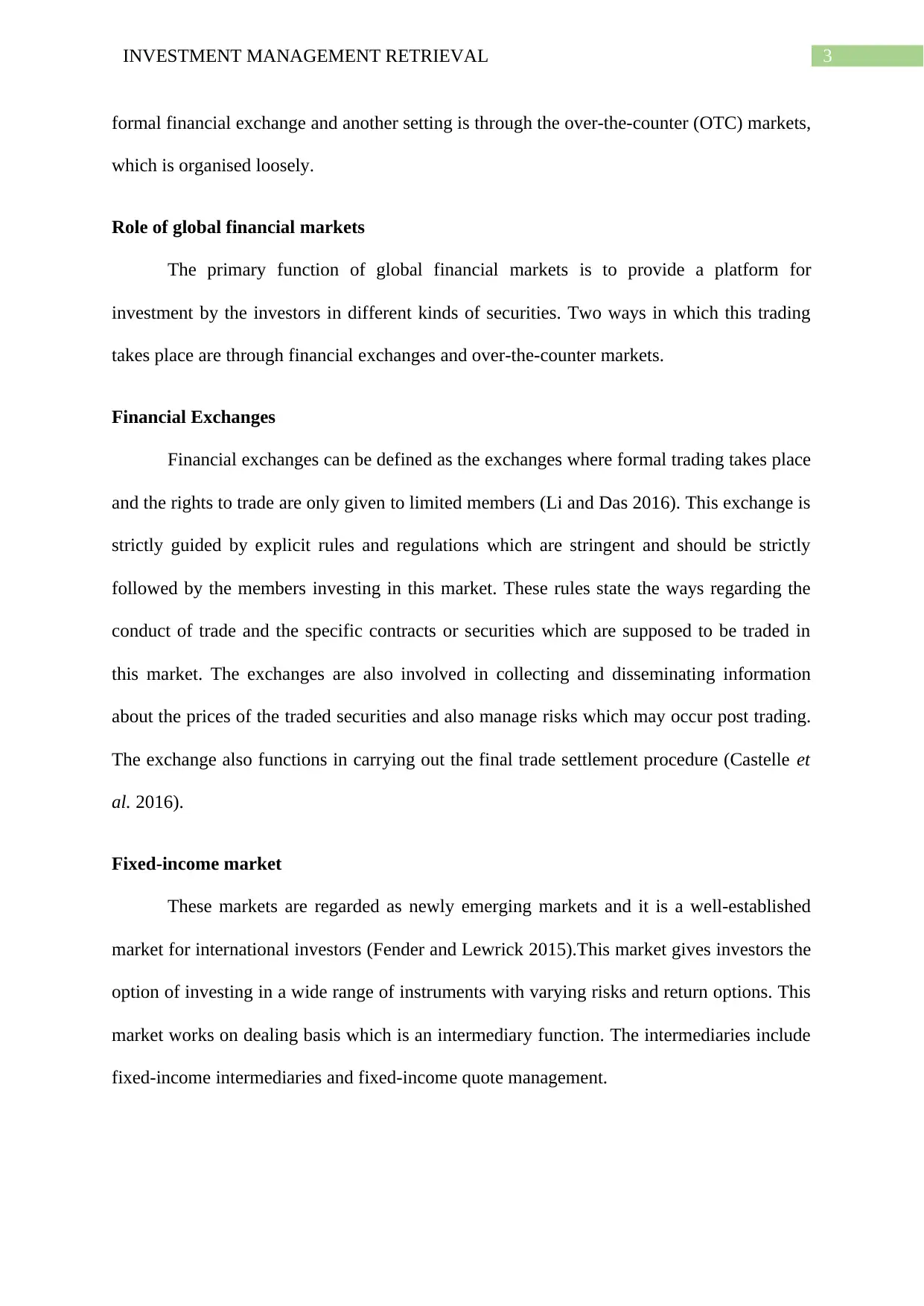
3INVESTMENT MANAGEMENT RETRIEVAL
formal financial exchange and another setting is through the over-the-counter (OTC) markets,
which is organised loosely.
Role of global financial markets
The primary function of global financial markets is to provide a platform for
investment by the investors in different kinds of securities. Two ways in which this trading
takes place are through financial exchanges and over-the-counter markets.
Financial Exchanges
Financial exchanges can be defined as the exchanges where formal trading takes place
and the rights to trade are only given to limited members (Li and Das 2016). This exchange is
strictly guided by explicit rules and regulations which are stringent and should be strictly
followed by the members investing in this market. These rules state the ways regarding the
conduct of trade and the specific contracts or securities which are supposed to be traded in
this market. The exchanges are also involved in collecting and disseminating information
about the prices of the traded securities and also manage risks which may occur post trading.
The exchange also functions in carrying out the final trade settlement procedure (Castelle et
al. 2016).
Fixed-income market
These markets are regarded as newly emerging markets and it is a well-established
market for international investors (Fender and Lewrick 2015).This market gives investors the
option of investing in a wide range of instruments with varying risks and return options. This
market works on dealing basis which is an intermediary function. The intermediaries include
fixed-income intermediaries and fixed-income quote management.
formal financial exchange and another setting is through the over-the-counter (OTC) markets,
which is organised loosely.
Role of global financial markets
The primary function of global financial markets is to provide a platform for
investment by the investors in different kinds of securities. Two ways in which this trading
takes place are through financial exchanges and over-the-counter markets.
Financial Exchanges
Financial exchanges can be defined as the exchanges where formal trading takes place
and the rights to trade are only given to limited members (Li and Das 2016). This exchange is
strictly guided by explicit rules and regulations which are stringent and should be strictly
followed by the members investing in this market. These rules state the ways regarding the
conduct of trade and the specific contracts or securities which are supposed to be traded in
this market. The exchanges are also involved in collecting and disseminating information
about the prices of the traded securities and also manage risks which may occur post trading.
The exchange also functions in carrying out the final trade settlement procedure (Castelle et
al. 2016).
Fixed-income market
These markets are regarded as newly emerging markets and it is a well-established
market for international investors (Fender and Lewrick 2015).This market gives investors the
option of investing in a wide range of instruments with varying risks and return options. This
market works on dealing basis which is an intermediary function. The intermediaries include
fixed-income intermediaries and fixed-income quote management.
Paraphrase This Document
Need a fresh take? Get an instant paraphrase of this document with our AI Paraphraser

4INVESTMENT MANAGEMENT RETRIEVAL
A number of Perspectives
The various perspectives that govern a fixed-income market can be country, business,
financial, interest rate, inflation and many others. In this paper, only three of such
perspectives are discussed.
1) Political Perspective
The different political perspectives could be reflationary action of the economy and positive
response of the global rates (Stiglitz 2015). There is possibility of fiscal expansion and
protection of trade. The monetary policy is getting diverged to an extreme level due to rise in
interest rates by the reserves. Due to reduction in liquidity the risk potential and the volatility
of market increases. Due to growth of financial liquidity, the price-return component of the
asset classes get flattered which in-turn suppressed the desired yields and spreads.
Interest rate and Inflation
Inflation is the concept which is related to bond price and bond yield. The value of the series
of future cash payments can be regarded as the function of the required return of the investors
based on his inflation expectations. Change in inflation can in turn affect the interest rate and
this leads to the creation of interest rate risk of the fixed-income securities. Due to change in
the interest rates over the period of time the price of the bond changes overtime which
automatically affects the yield of the bond.
2) Business Perspective
Due to presence of fixed-income securities the investors can get stable income throughout
their period of investment and hence they can have an optimal balanced portfolio (Dabla-
Norris et al. 2015). The fixed-income securities are risk-adjusted. Therefore, the business can
add fixed income securities in their portfolio in order to get stable return of the business
throughout the entire investment period without any hassle of risk.
A number of Perspectives
The various perspectives that govern a fixed-income market can be country, business,
financial, interest rate, inflation and many others. In this paper, only three of such
perspectives are discussed.
1) Political Perspective
The different political perspectives could be reflationary action of the economy and positive
response of the global rates (Stiglitz 2015). There is possibility of fiscal expansion and
protection of trade. The monetary policy is getting diverged to an extreme level due to rise in
interest rates by the reserves. Due to reduction in liquidity the risk potential and the volatility
of market increases. Due to growth of financial liquidity, the price-return component of the
asset classes get flattered which in-turn suppressed the desired yields and spreads.
Interest rate and Inflation
Inflation is the concept which is related to bond price and bond yield. The value of the series
of future cash payments can be regarded as the function of the required return of the investors
based on his inflation expectations. Change in inflation can in turn affect the interest rate and
this leads to the creation of interest rate risk of the fixed-income securities. Due to change in
the interest rates over the period of time the price of the bond changes overtime which
automatically affects the yield of the bond.
2) Business Perspective
Due to presence of fixed-income securities the investors can get stable income throughout
their period of investment and hence they can have an optimal balanced portfolio (Dabla-
Norris et al. 2015). The fixed-income securities are risk-adjusted. Therefore, the business can
add fixed income securities in their portfolio in order to get stable return of the business
throughout the entire investment period without any hassle of risk.
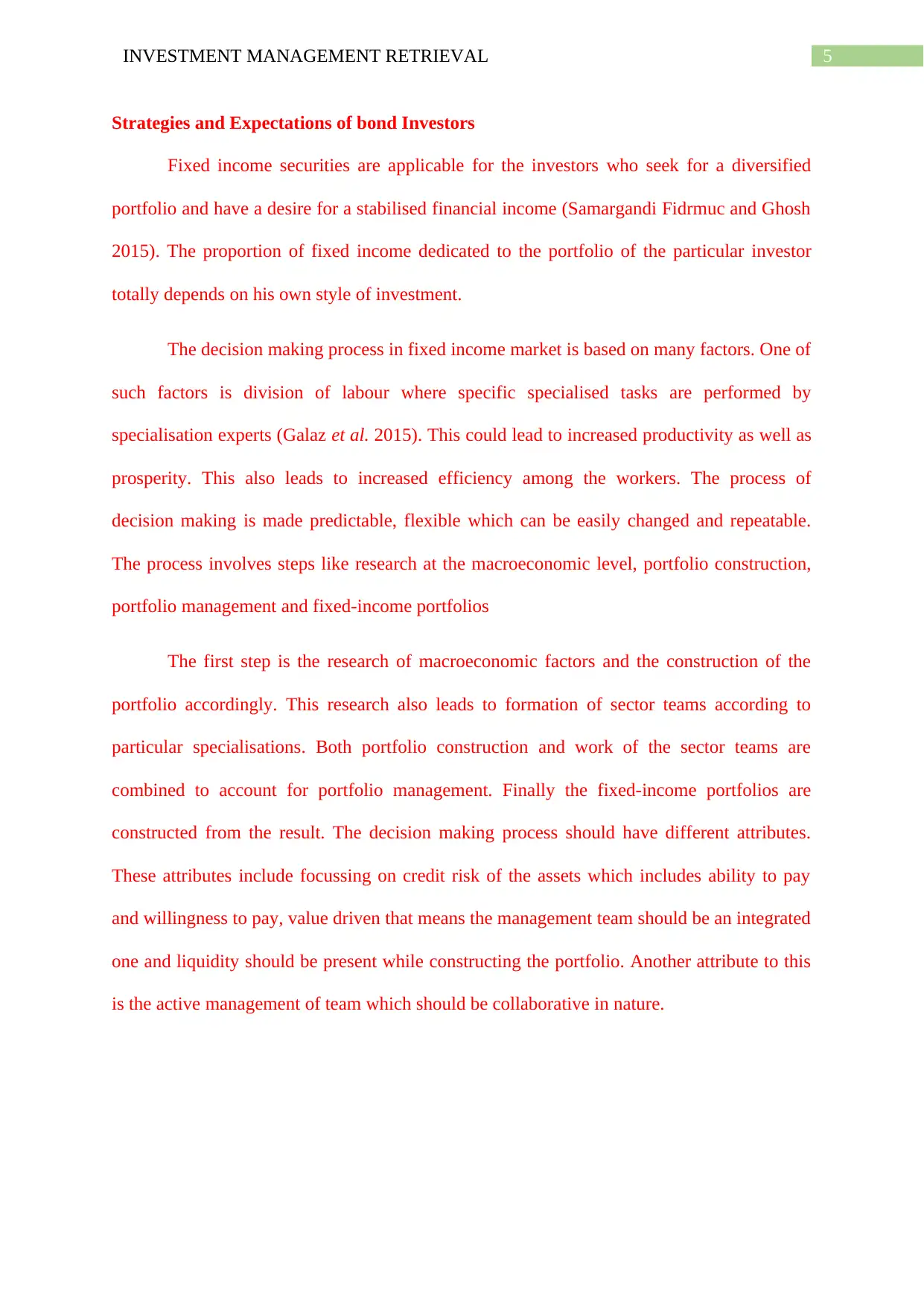
5INVESTMENT MANAGEMENT RETRIEVAL
Strategies and Expectations of bond Investors
Fixed income securities are applicable for the investors who seek for a diversified
portfolio and have a desire for a stabilised financial income (Samargandi Fidrmuc and Ghosh
2015). The proportion of fixed income dedicated to the portfolio of the particular investor
totally depends on his own style of investment.
The decision making process in fixed income market is based on many factors. One of
such factors is division of labour where specific specialised tasks are performed by
specialisation experts (Galaz et al. 2015). This could lead to increased productivity as well as
prosperity. This also leads to increased efficiency among the workers. The process of
decision making is made predictable, flexible which can be easily changed and repeatable.
The process involves steps like research at the macroeconomic level, portfolio construction,
portfolio management and fixed-income portfolios
The first step is the research of macroeconomic factors and the construction of the
portfolio accordingly. This research also leads to formation of sector teams according to
particular specialisations. Both portfolio construction and work of the sector teams are
combined to account for portfolio management. Finally the fixed-income portfolios are
constructed from the result. The decision making process should have different attributes.
These attributes include focussing on credit risk of the assets which includes ability to pay
and willingness to pay, value driven that means the management team should be an integrated
one and liquidity should be present while constructing the portfolio. Another attribute to this
is the active management of team which should be collaborative in nature.
Strategies and Expectations of bond Investors
Fixed income securities are applicable for the investors who seek for a diversified
portfolio and have a desire for a stabilised financial income (Samargandi Fidrmuc and Ghosh
2015). The proportion of fixed income dedicated to the portfolio of the particular investor
totally depends on his own style of investment.
The decision making process in fixed income market is based on many factors. One of
such factors is division of labour where specific specialised tasks are performed by
specialisation experts (Galaz et al. 2015). This could lead to increased productivity as well as
prosperity. This also leads to increased efficiency among the workers. The process of
decision making is made predictable, flexible which can be easily changed and repeatable.
The process involves steps like research at the macroeconomic level, portfolio construction,
portfolio management and fixed-income portfolios
The first step is the research of macroeconomic factors and the construction of the
portfolio accordingly. This research also leads to formation of sector teams according to
particular specialisations. Both portfolio construction and work of the sector teams are
combined to account for portfolio management. Finally the fixed-income portfolios are
constructed from the result. The decision making process should have different attributes.
These attributes include focussing on credit risk of the assets which includes ability to pay
and willingness to pay, value driven that means the management team should be an integrated
one and liquidity should be present while constructing the portfolio. Another attribute to this
is the active management of team which should be collaborative in nature.
⊘ This is a preview!⊘
Do you want full access?
Subscribe today to unlock all pages.

Trusted by 1+ million students worldwide
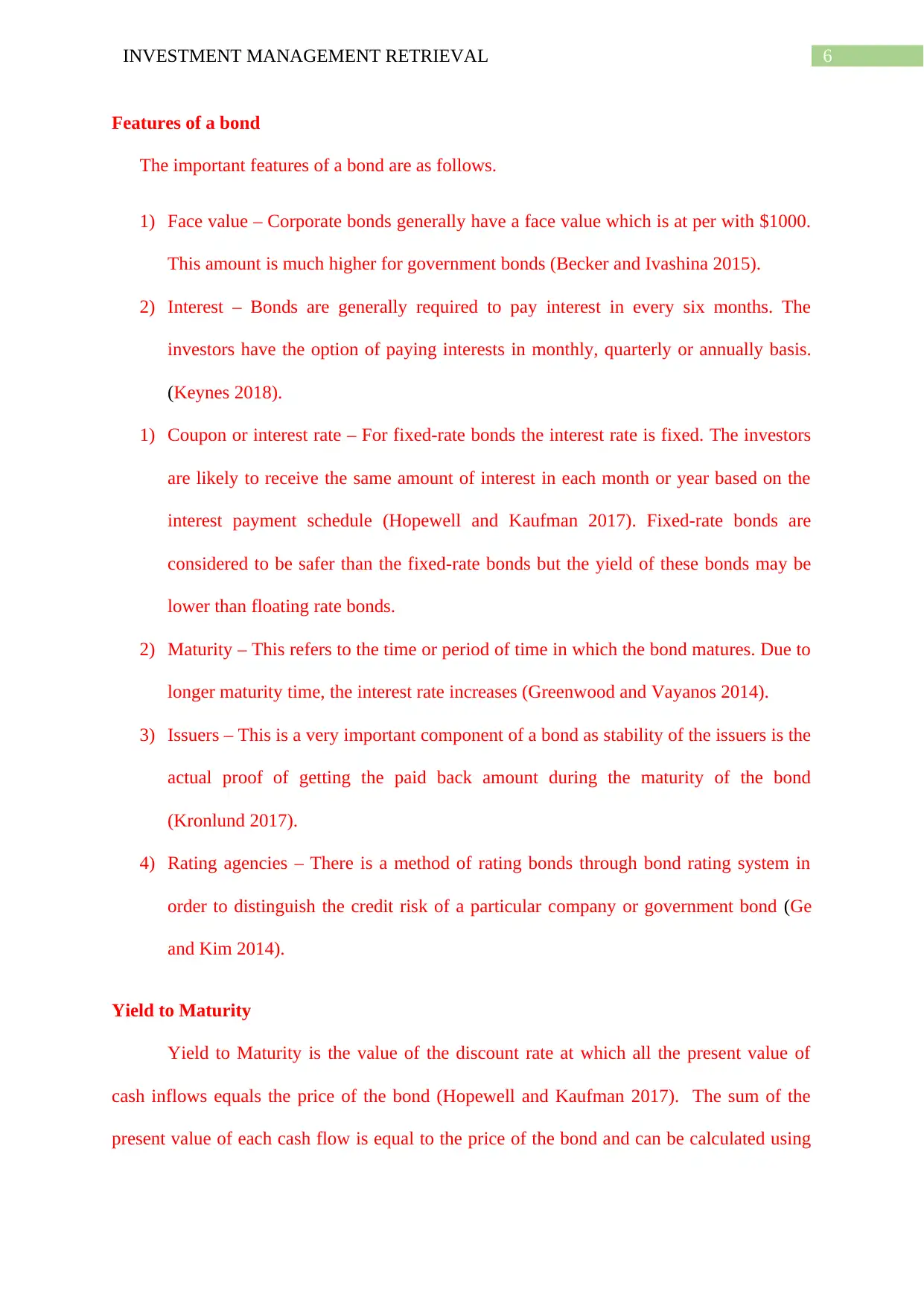
6INVESTMENT MANAGEMENT RETRIEVAL
Features of a bond
The important features of a bond are as follows.
1) Face value – Corporate bonds generally have a face value which is at per with $1000.
This amount is much higher for government bonds (Becker and Ivashina 2015).
2) Interest – Bonds are generally required to pay interest in every six months. The
investors have the option of paying interests in monthly, quarterly or annually basis.
(Keynes 2018).
1) Coupon or interest rate – For fixed-rate bonds the interest rate is fixed. The investors
are likely to receive the same amount of interest in each month or year based on the
interest payment schedule (Hopewell and Kaufman 2017). Fixed-rate bonds are
considered to be safer than the fixed-rate bonds but the yield of these bonds may be
lower than floating rate bonds.
2) Maturity – This refers to the time or period of time in which the bond matures. Due to
longer maturity time, the interest rate increases (Greenwood and Vayanos 2014).
3) Issuers – This is a very important component of a bond as stability of the issuers is the
actual proof of getting the paid back amount during the maturity of the bond
(Kronlund 2017).
4) Rating agencies – There is a method of rating bonds through bond rating system in
order to distinguish the credit risk of a particular company or government bond (Ge
and Kim 2014).
Yield to Maturity
Yield to Maturity is the value of the discount rate at which all the present value of
cash inflows equals the price of the bond (Hopewell and Kaufman 2017). The sum of the
present value of each cash flow is equal to the price of the bond and can be calculated using
Features of a bond
The important features of a bond are as follows.
1) Face value – Corporate bonds generally have a face value which is at per with $1000.
This amount is much higher for government bonds (Becker and Ivashina 2015).
2) Interest – Bonds are generally required to pay interest in every six months. The
investors have the option of paying interests in monthly, quarterly or annually basis.
(Keynes 2018).
1) Coupon or interest rate – For fixed-rate bonds the interest rate is fixed. The investors
are likely to receive the same amount of interest in each month or year based on the
interest payment schedule (Hopewell and Kaufman 2017). Fixed-rate bonds are
considered to be safer than the fixed-rate bonds but the yield of these bonds may be
lower than floating rate bonds.
2) Maturity – This refers to the time or period of time in which the bond matures. Due to
longer maturity time, the interest rate increases (Greenwood and Vayanos 2014).
3) Issuers – This is a very important component of a bond as stability of the issuers is the
actual proof of getting the paid back amount during the maturity of the bond
(Kronlund 2017).
4) Rating agencies – There is a method of rating bonds through bond rating system in
order to distinguish the credit risk of a particular company or government bond (Ge
and Kim 2014).
Yield to Maturity
Yield to Maturity is the value of the discount rate at which all the present value of
cash inflows equals the price of the bond (Hopewell and Kaufman 2017). The sum of the
present value of each cash flow is equal to the price of the bond and can be calculated using
Paraphrase This Document
Need a fresh take? Get an instant paraphrase of this document with our AI Paraphraser
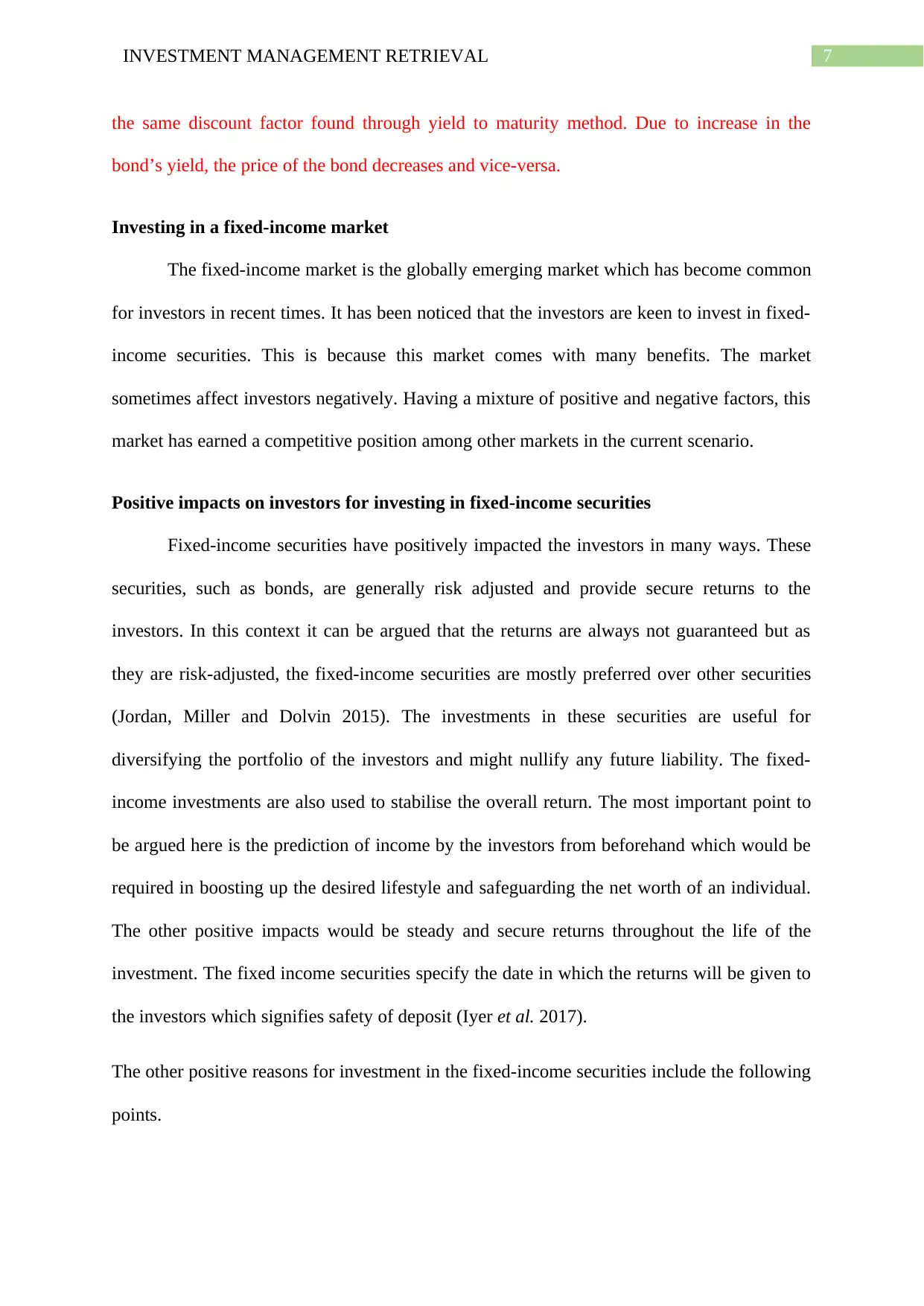
7INVESTMENT MANAGEMENT RETRIEVAL
the same discount factor found through yield to maturity method. Due to increase in the
bond’s yield, the price of the bond decreases and vice-versa.
Investing in a fixed-income market
The fixed-income market is the globally emerging market which has become common
for investors in recent times. It has been noticed that the investors are keen to invest in fixed-
income securities. This is because this market comes with many benefits. The market
sometimes affect investors negatively. Having a mixture of positive and negative factors, this
market has earned a competitive position among other markets in the current scenario.
Positive impacts on investors for investing in fixed-income securities
Fixed-income securities have positively impacted the investors in many ways. These
securities, such as bonds, are generally risk adjusted and provide secure returns to the
investors. In this context it can be argued that the returns are always not guaranteed but as
they are risk-adjusted, the fixed-income securities are mostly preferred over other securities
(Jordan, Miller and Dolvin 2015). The investments in these securities are useful for
diversifying the portfolio of the investors and might nullify any future liability. The fixed-
income investments are also used to stabilise the overall return. The most important point to
be argued here is the prediction of income by the investors from beforehand which would be
required in boosting up the desired lifestyle and safeguarding the net worth of an individual.
The other positive impacts would be steady and secure returns throughout the life of the
investment. The fixed income securities specify the date in which the returns will be given to
the investors which signifies safety of deposit (Iyer et al. 2017).
The other positive reasons for investment in the fixed-income securities include the following
points.
the same discount factor found through yield to maturity method. Due to increase in the
bond’s yield, the price of the bond decreases and vice-versa.
Investing in a fixed-income market
The fixed-income market is the globally emerging market which has become common
for investors in recent times. It has been noticed that the investors are keen to invest in fixed-
income securities. This is because this market comes with many benefits. The market
sometimes affect investors negatively. Having a mixture of positive and negative factors, this
market has earned a competitive position among other markets in the current scenario.
Positive impacts on investors for investing in fixed-income securities
Fixed-income securities have positively impacted the investors in many ways. These
securities, such as bonds, are generally risk adjusted and provide secure returns to the
investors. In this context it can be argued that the returns are always not guaranteed but as
they are risk-adjusted, the fixed-income securities are mostly preferred over other securities
(Jordan, Miller and Dolvin 2015). The investments in these securities are useful for
diversifying the portfolio of the investors and might nullify any future liability. The fixed-
income investments are also used to stabilise the overall return. The most important point to
be argued here is the prediction of income by the investors from beforehand which would be
required in boosting up the desired lifestyle and safeguarding the net worth of an individual.
The other positive impacts would be steady and secure returns throughout the life of the
investment. The fixed income securities specify the date in which the returns will be given to
the investors which signifies safety of deposit (Iyer et al. 2017).
The other positive reasons for investment in the fixed-income securities include the following
points.
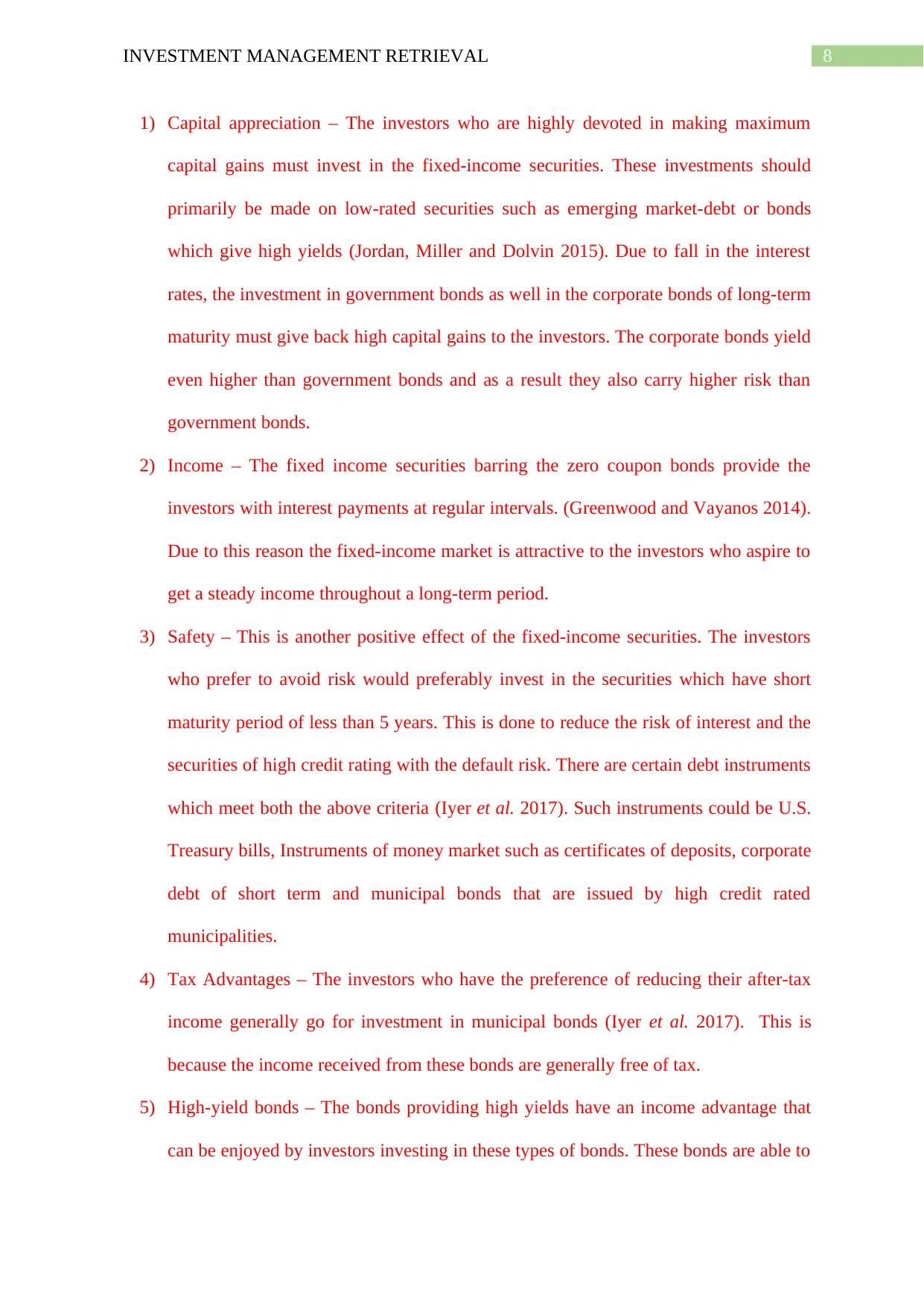
8INVESTMENT MANAGEMENT RETRIEVAL
1) Capital appreciation – The investors who are highly devoted in making maximum
capital gains must invest in the fixed-income securities. These investments should
primarily be made on low-rated securities such as emerging market-debt or bonds
which give high yields (Jordan, Miller and Dolvin 2015). Due to fall in the interest
rates, the investment in government bonds as well in the corporate bonds of long-term
maturity must give back high capital gains to the investors. The corporate bonds yield
even higher than government bonds and as a result they also carry higher risk than
government bonds.
2) Income – The fixed income securities barring the zero coupon bonds provide the
investors with interest payments at regular intervals. (Greenwood and Vayanos 2014).
Due to this reason the fixed-income market is attractive to the investors who aspire to
get a steady income throughout a long-term period.
3) Safety – This is another positive effect of the fixed-income securities. The investors
who prefer to avoid risk would preferably invest in the securities which have short
maturity period of less than 5 years. This is done to reduce the risk of interest and the
securities of high credit rating with the default risk. There are certain debt instruments
which meet both the above criteria (Iyer et al. 2017). Such instruments could be U.S.
Treasury bills, Instruments of money market such as certificates of deposits, corporate
debt of short term and municipal bonds that are issued by high credit rated
municipalities.
4) Tax Advantages – The investors who have the preference of reducing their after-tax
income generally go for investment in municipal bonds (Iyer et al. 2017). This is
because the income received from these bonds are generally free of tax.
5) High-yield bonds – The bonds providing high yields have an income advantage that
can be enjoyed by investors investing in these types of bonds. These bonds are able to
1) Capital appreciation – The investors who are highly devoted in making maximum
capital gains must invest in the fixed-income securities. These investments should
primarily be made on low-rated securities such as emerging market-debt or bonds
which give high yields (Jordan, Miller and Dolvin 2015). Due to fall in the interest
rates, the investment in government bonds as well in the corporate bonds of long-term
maturity must give back high capital gains to the investors. The corporate bonds yield
even higher than government bonds and as a result they also carry higher risk than
government bonds.
2) Income – The fixed income securities barring the zero coupon bonds provide the
investors with interest payments at regular intervals. (Greenwood and Vayanos 2014).
Due to this reason the fixed-income market is attractive to the investors who aspire to
get a steady income throughout a long-term period.
3) Safety – This is another positive effect of the fixed-income securities. The investors
who prefer to avoid risk would preferably invest in the securities which have short
maturity period of less than 5 years. This is done to reduce the risk of interest and the
securities of high credit rating with the default risk. There are certain debt instruments
which meet both the above criteria (Iyer et al. 2017). Such instruments could be U.S.
Treasury bills, Instruments of money market such as certificates of deposits, corporate
debt of short term and municipal bonds that are issued by high credit rated
municipalities.
4) Tax Advantages – The investors who have the preference of reducing their after-tax
income generally go for investment in municipal bonds (Iyer et al. 2017). This is
because the income received from these bonds are generally free of tax.
5) High-yield bonds – The bonds providing high yields have an income advantage that
can be enjoyed by investors investing in these types of bonds. These bonds are able to
⊘ This is a preview!⊘
Do you want full access?
Subscribe today to unlock all pages.

Trusted by 1+ million students worldwide

9INVESTMENT MANAGEMENT RETRIEVAL
offset all the negative price returns that occur due to rise in interest rates (Valdez and
Molyneux 2015).These bonds are less sensitive to interest rate fluctuations than
intermediate-term bonds as the high-yield bonds have shorter duration.
Negative impacts
Investors investing in fixed-income securities are faced with different kinds of risks
(Cardella et al. 2014). These risks include credit risk, liquidity risk, interest rate risk, and
others. Some of these risks are discussed below.
1) Credit risk – This risk primarily affect the bonds. These risks occur due to the default
of the issuer to pay interest or principal in a timely manner. These risks may also
occur due to inability in complying with the provisions that affect the indenture of the
bonds. The bonds having a lower credit ranking generally come with greater financial
risk as they provide higher returns and those have lower credit ranking would have
low risk with low return (Härdle, Chen and Overbeck 2017). This risk mainly defines
the risk that comes with investing in securities, mainly in bonds, that come with
higher returns.
1) Liquidity risk – This risk is associated with liquidity of securities. Most of the fixed
income securities maintain a secondary market for trading of securities by investors.
Failure to maintain such a market may result in the liquidity risk as the investors fail
to liquidate or sell his securities (Junge and Trolle 2015). There may have been
conditions of low liquidity which arise when the time taken for trading in secondary
market takes more than the required time. In such a case the money of the investors
get locked until the complete maturity period.
2) Interest rate risk – This risk occurs due to changes in interest rates over the globe. Due
to change in interest rates, the prices of the assets will decline. The prices of the bonds
are also driven by fluctuations in interest rates. This risk can be mitigated by
offset all the negative price returns that occur due to rise in interest rates (Valdez and
Molyneux 2015).These bonds are less sensitive to interest rate fluctuations than
intermediate-term bonds as the high-yield bonds have shorter duration.
Negative impacts
Investors investing in fixed-income securities are faced with different kinds of risks
(Cardella et al. 2014). These risks include credit risk, liquidity risk, interest rate risk, and
others. Some of these risks are discussed below.
1) Credit risk – This risk primarily affect the bonds. These risks occur due to the default
of the issuer to pay interest or principal in a timely manner. These risks may also
occur due to inability in complying with the provisions that affect the indenture of the
bonds. The bonds having a lower credit ranking generally come with greater financial
risk as they provide higher returns and those have lower credit ranking would have
low risk with low return (Härdle, Chen and Overbeck 2017). This risk mainly defines
the risk that comes with investing in securities, mainly in bonds, that come with
higher returns.
1) Liquidity risk – This risk is associated with liquidity of securities. Most of the fixed
income securities maintain a secondary market for trading of securities by investors.
Failure to maintain such a market may result in the liquidity risk as the investors fail
to liquidate or sell his securities (Junge and Trolle 2015). There may have been
conditions of low liquidity which arise when the time taken for trading in secondary
market takes more than the required time. In such a case the money of the investors
get locked until the complete maturity period.
2) Interest rate risk – This risk occurs due to changes in interest rates over the globe. Due
to change in interest rates, the prices of the assets will decline. The prices of the bonds
are also driven by fluctuations in interest rates. This risk can be mitigated by
Paraphrase This Document
Need a fresh take? Get an instant paraphrase of this document with our AI Paraphraser
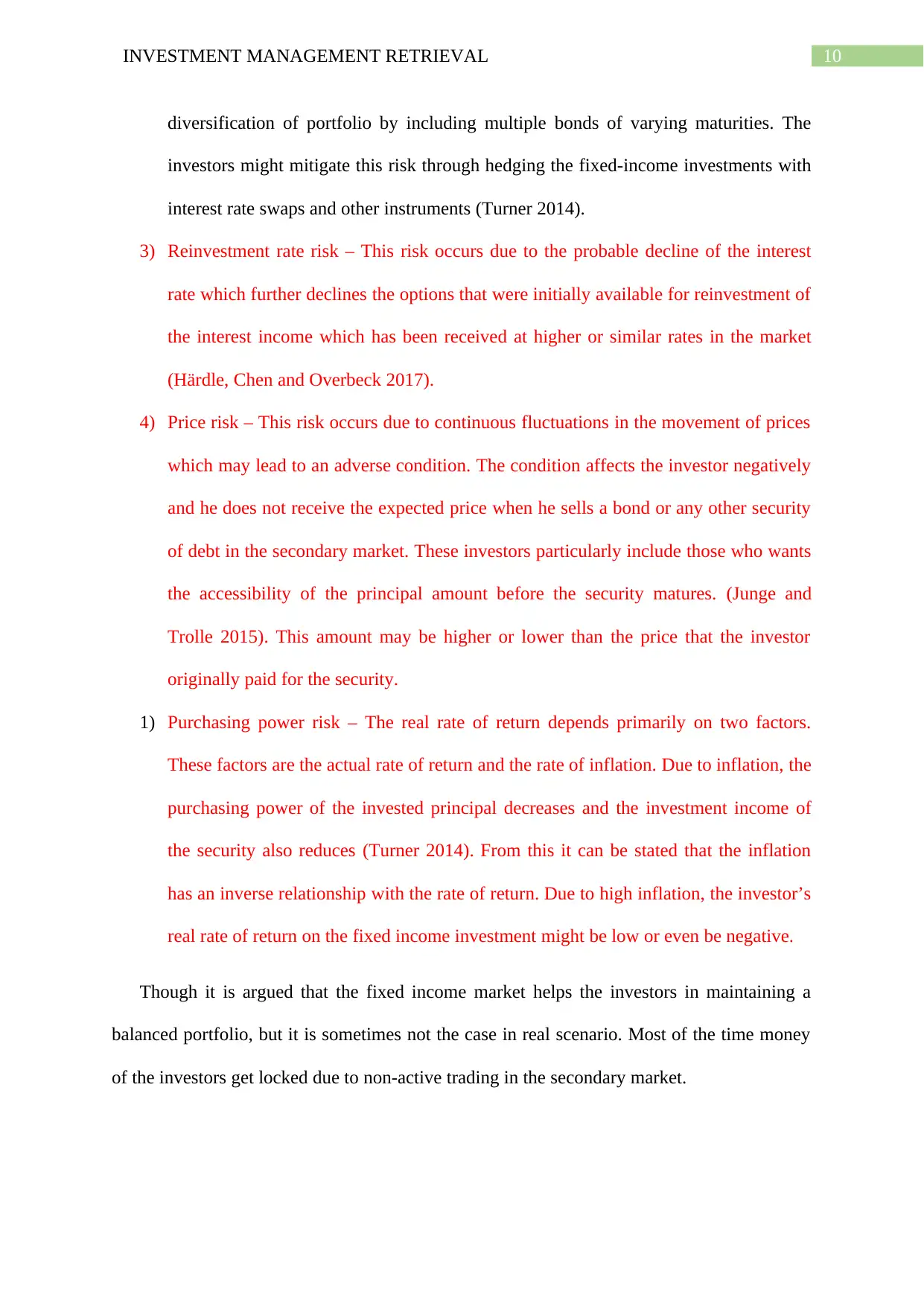
10INVESTMENT MANAGEMENT RETRIEVAL
diversification of portfolio by including multiple bonds of varying maturities. The
investors might mitigate this risk through hedging the fixed-income investments with
interest rate swaps and other instruments (Turner 2014).
3) Reinvestment rate risk – This risk occurs due to the probable decline of the interest
rate which further declines the options that were initially available for reinvestment of
the interest income which has been received at higher or similar rates in the market
(Härdle, Chen and Overbeck 2017).
4) Price risk – This risk occurs due to continuous fluctuations in the movement of prices
which may lead to an adverse condition. The condition affects the investor negatively
and he does not receive the expected price when he sells a bond or any other security
of debt in the secondary market. These investors particularly include those who wants
the accessibility of the principal amount before the security matures. (Junge and
Trolle 2015). This amount may be higher or lower than the price that the investor
originally paid for the security.
1) Purchasing power risk – The real rate of return depends primarily on two factors.
These factors are the actual rate of return and the rate of inflation. Due to inflation, the
purchasing power of the invested principal decreases and the investment income of
the security also reduces (Turner 2014). From this it can be stated that the inflation
has an inverse relationship with the rate of return. Due to high inflation, the investor’s
real rate of return on the fixed income investment might be low or even be negative.
Though it is argued that the fixed income market helps the investors in maintaining a
balanced portfolio, but it is sometimes not the case in real scenario. Most of the time money
of the investors get locked due to non-active trading in the secondary market.
diversification of portfolio by including multiple bonds of varying maturities. The
investors might mitigate this risk through hedging the fixed-income investments with
interest rate swaps and other instruments (Turner 2014).
3) Reinvestment rate risk – This risk occurs due to the probable decline of the interest
rate which further declines the options that were initially available for reinvestment of
the interest income which has been received at higher or similar rates in the market
(Härdle, Chen and Overbeck 2017).
4) Price risk – This risk occurs due to continuous fluctuations in the movement of prices
which may lead to an adverse condition. The condition affects the investor negatively
and he does not receive the expected price when he sells a bond or any other security
of debt in the secondary market. These investors particularly include those who wants
the accessibility of the principal amount before the security matures. (Junge and
Trolle 2015). This amount may be higher or lower than the price that the investor
originally paid for the security.
1) Purchasing power risk – The real rate of return depends primarily on two factors.
These factors are the actual rate of return and the rate of inflation. Due to inflation, the
purchasing power of the invested principal decreases and the investment income of
the security also reduces (Turner 2014). From this it can be stated that the inflation
has an inverse relationship with the rate of return. Due to high inflation, the investor’s
real rate of return on the fixed income investment might be low or even be negative.
Though it is argued that the fixed income market helps the investors in maintaining a
balanced portfolio, but it is sometimes not the case in real scenario. Most of the time money
of the investors get locked due to non-active trading in the secondary market.
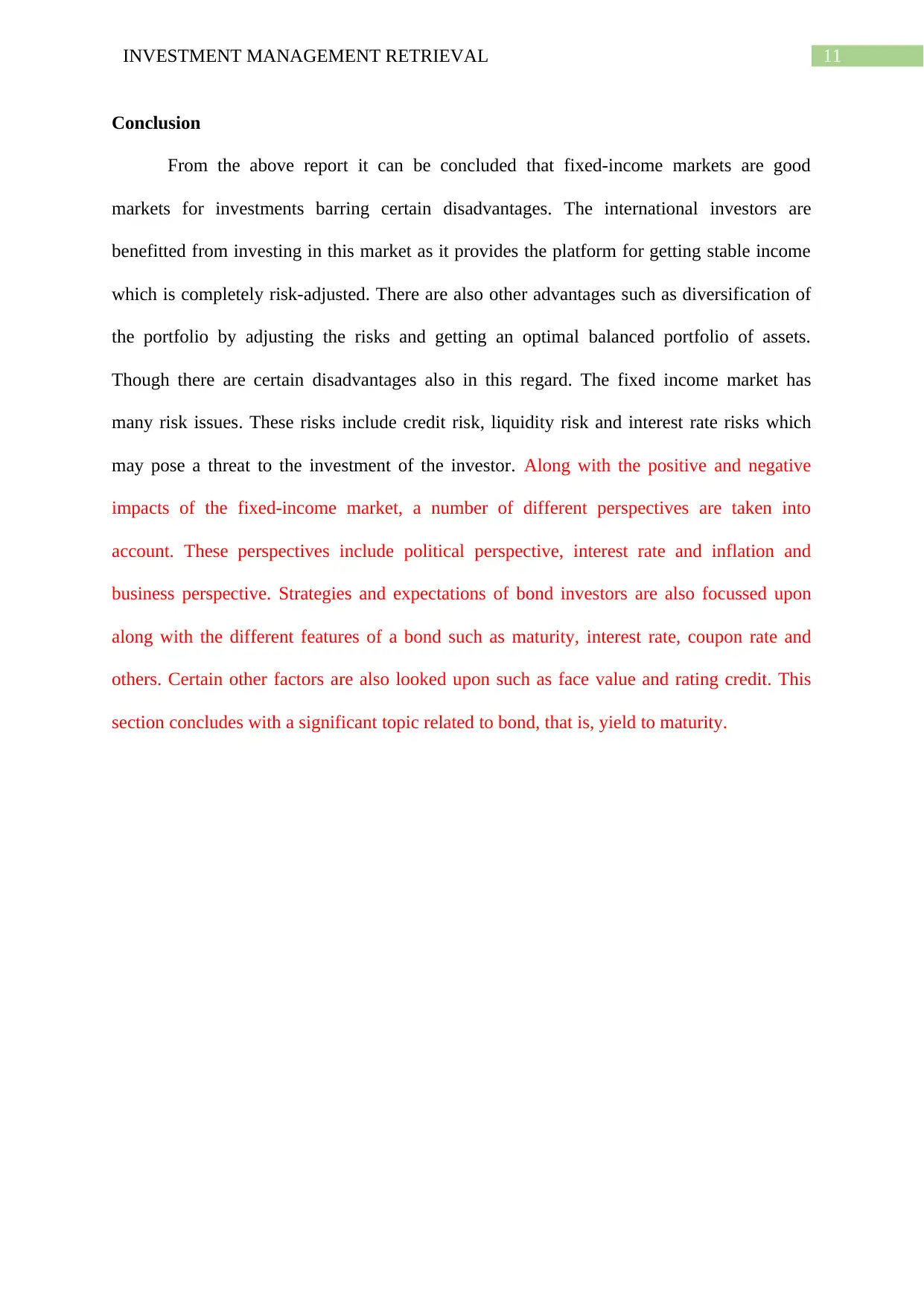
11INVESTMENT MANAGEMENT RETRIEVAL
Conclusion
From the above report it can be concluded that fixed-income markets are good
markets for investments barring certain disadvantages. The international investors are
benefitted from investing in this market as it provides the platform for getting stable income
which is completely risk-adjusted. There are also other advantages such as diversification of
the portfolio by adjusting the risks and getting an optimal balanced portfolio of assets.
Though there are certain disadvantages also in this regard. The fixed income market has
many risk issues. These risks include credit risk, liquidity risk and interest rate risks which
may pose a threat to the investment of the investor. Along with the positive and negative
impacts of the fixed-income market, a number of different perspectives are taken into
account. These perspectives include political perspective, interest rate and inflation and
business perspective. Strategies and expectations of bond investors are also focussed upon
along with the different features of a bond such as maturity, interest rate, coupon rate and
others. Certain other factors are also looked upon such as face value and rating credit. This
section concludes with a significant topic related to bond, that is, yield to maturity.
Conclusion
From the above report it can be concluded that fixed-income markets are good
markets for investments barring certain disadvantages. The international investors are
benefitted from investing in this market as it provides the platform for getting stable income
which is completely risk-adjusted. There are also other advantages such as diversification of
the portfolio by adjusting the risks and getting an optimal balanced portfolio of assets.
Though there are certain disadvantages also in this regard. The fixed income market has
many risk issues. These risks include credit risk, liquidity risk and interest rate risks which
may pose a threat to the investment of the investor. Along with the positive and negative
impacts of the fixed-income market, a number of different perspectives are taken into
account. These perspectives include political perspective, interest rate and inflation and
business perspective. Strategies and expectations of bond investors are also focussed upon
along with the different features of a bond such as maturity, interest rate, coupon rate and
others. Certain other factors are also looked upon such as face value and rating credit. This
section concludes with a significant topic related to bond, that is, yield to maturity.
⊘ This is a preview!⊘
Do you want full access?
Subscribe today to unlock all pages.

Trusted by 1+ million students worldwide
1 out of 15
Related Documents
Your All-in-One AI-Powered Toolkit for Academic Success.
+13062052269
info@desklib.com
Available 24*7 on WhatsApp / Email
![[object Object]](/_next/static/media/star-bottom.7253800d.svg)
Unlock your academic potential
Copyright © 2020–2025 A2Z Services. All Rights Reserved. Developed and managed by ZUCOL.





